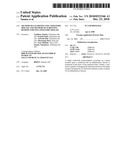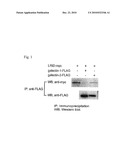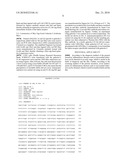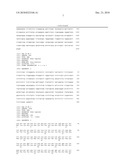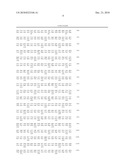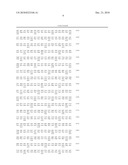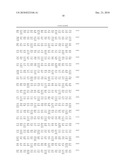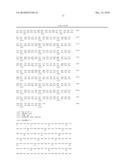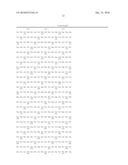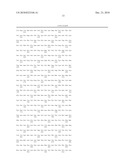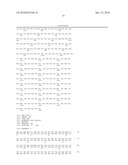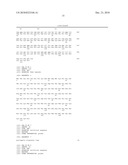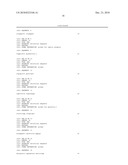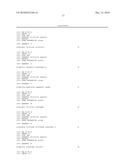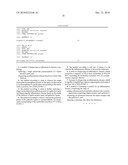Patent application title: Method of Examining Inflammatory Disease and Method of Screening Remedy for Inflammatory Disease
Inventors:
Toshihisa Tanaka (Yokohama-Shi, JP)
Koichi Ozaki (Yokohama-Shi, JP)
Aritoshi Iida (Yokohama-Shi, JP)
Masatsugu Hori (Suita-Shi, JP)
Yozo Ohnishi (Tokyo, JP)
Yusuke Nakamura (Yokohama-Shi, JP)
Assignees:
RIKEN
IPC8 Class: AC12Q168FI
USPC Class:
435 6
Class name: Chemistry: molecular biology and microbiology measuring or testing process involving enzymes or micro-organisms; composition or test strip therefore; processes of forming such composition or test strip involving nucleic acid
Publication date: 2010-12-23
Patent application number: 20100323346
Claims:
1. A method of diagnosing an inflammatory disease, comprising:analyzing a
single nucleotide polymorphism of a leptin receptor gene, anddiagnosing
an inflammatory disease based on a result of the analysis.
2. The method according to claim 1, wherein the single nucleotide polymorphism present on the leptin receptor gene is a polymorphism of a nucleotide corresponding to the nucleotide at position 164 of SEQ ID NO: 1.
3. The method according to claim 1, further analyzing a single nucleotide polymorphism present on a galectin-2 gene and diagnosing the inflammatory disease based on the results of the analysis of leptin receptor gene and galectin-2 gene.
4. The method according to claim 3, wherein the polymorphism of the galectin-2 gene is a polymorphism of a nucleotide corresponding to the nucleotide at position 377 of SEQ ID NO: 2.
5. The method according to any one of claims 1 to 4, wherein the inflammatory disease is myocardial infarction.
6. A probe for diagnosing an inflammatory disease, which comprises a sequence of 10 or more nucleotides in SEQ ID NO: 1 including the nucleotide at position 164, or a complementary sequence thereof.
7. A primer for diagnosing an inflammatory disease, which is capable of amplifying a region comprising the nucleotide at position 164 of SEQ ID NO: 1.
8. A method of screening a remedy for an inflammatory disease, comprising the steps of:adding a pharmaceutical candidate substance into a screening system comprising a leptin receptor and a galectin-2;measuring an interaction between the leptin receptor and the galectin-2; andselecting a substance that alters the interaction.
Description:
TECHNICAL FIELD
[0001]The present invention relates to a method of diagnosing an inflammatory disease such as myocardial infarction, and a method of screening a remedy for an inflammatory disease.
BACKGROUND ART
[0002]In recent years, risks of death in coronary diseases such as myocardial infarction have increased with changes in life styles (Non-patent Document 1 or 2). Therefore, a method of diagnosing a critical risk for any of those diseases at an early stage has been expected to be developed.
[0003]The possibilities of development of coronary diseases such as myocardial infarction due to genetic predispositions have been suggested in the art. Several methods of diagnosing myocardial infarction on the basis of the presence or absence of a gene mutation have been known in the art. For instance, a method of diagnosing a risk of the onset of myocardial infarction by analyzing the polymorphism of a prostacyclin synthase gene has been known (Patent Document 1). However, for diagnosing more precisely, another method for the diagnosis has been expected to be developed.
[0004]A leptin receptor is a single-spanning membrane receptor that transmits a signal of leptin that is involved in regulation of food intake and energy expenditure (Non-patent Document 3). It has been known that polymorphisms in some regions of a gene encoding leption receptor are associated with metabolic diseases such as obesity (Non-patent Document 3). Polymorphisms in several portions of a gene that encodes the leptin receptor have been known to relate to asthma (a polymorphism that replaces Q with R: Non-patent Document 4). However, there is no finding with respect to the relationship between the polymorphism of the leptin receptor gene and inflammatory diseases such as myocardial infarction.
[0005]Galectins are proteins having affinities for galactose. In mammals, at present, 10 different galectins are known. Among those, galectin-2 is known to form a noncovalent homodimer composed of a 14 KDa subunit and it is self-aggregated to lose its activity in the absence of a reducing agent. In addition, the details of physiological functions of galectin-2 have not been known even though in many cases the expression of galectin-2 is found in epithelial cells in normal adult human tissues, mainly in the lower part of the small intestine (Non-patent Document 5). [0006]Patent Document 1: JP2002-136291 [0007]Non-patent Document 1: Nature Medicine, 1997, vol. 3, p 600-601 [0008]Non-patent Document 2: New England Journal of Medicine, 1997, vol. 337, p 1360-1369 [0009]Non-patent Document 3: Cell, 1995, vol. 83, p 1263-1271 [0010]Non-patent Document 4: Hum Genet., 2001, vol. 108(3), p 233-236 [0011]Non-patent Document 5: Trends in Glycoscience and Glycotechnology, 1997, vol. 9, No. 45, p 87-93
DISCLOSURE OF THE INVENTION
[0012]An object of the present invention is to provide a method of precisely diagnosing a risk of the onset of an inflammatory disease such as myocardial infarction, or the presence or absence of the onset thereof. Another object of the present invention is to provide a method of screening a remedy for an inflammatory disease, such as myocardial infarction.
[0013]The inventors of the present invention have intensively studied for solving the above-mentioned objects. As a result, the inventors of the present invention have found that a single nucleotide polymorphism of a leptin receptor gene is associated with myocardial infarction. In addition, the inventors of the present invention have found that the leptin receptor shows a specific interaction with galectin-2 and thus a remedy for an inflammatory disease, such as myocardial infarction, can be obtained by screening a substance capable of altering the interaction, thereby completed the present invention.
[0014]That is, the present invention provides the followings.
[0015](1) A method of diagnosing an inflammatory disease, comprising: analyzing a single nucleotide polymorphism of a leptin receptor gene, and diagnosing an inflammatory disease based on a result of the analysis.
[0016](2) The method according to (1), wherein the single nucleotide polymorphism present on the leptin receptor gene is a polymorphism of a nucleotide corresponding to the nucleotide at position 164 of SEQ ID NO: 1.
[0017](3) The method according to (1), further analyzing a single nucleotide polymorphism present on a galectin-2 gene and diagnosing the inflammatory disease based on the results of the analysis of leptin receptor gene and galectin-2 gene.
[0018](4) The method according to (3), wherein the polymorphism of the galectin-2 gene is a polymorphism of a nucleotide corresponding to the nucleotide at position 377 of SEQ ID NO: 2.
[0019](5) The method according to any one of (1) to (4), wherein the inflammatory disease is myocardial infarction.
[0020](6) A probe for diagnosing an inflammatory disease, which comprises a sequence of 10 or more nucleotides in SEQ ID NO: 1 including the nucleotide at position 164, or a complementary sequence thereof.
[0021](7) A primer for diagnosing an inflammatory disease, which is capable of amplifying a region comprising the nucleotide at position 164 of SEQ ID NO: 1.
[0022](8) A method of screening a remedy for an inflammatory disease, comprising the steps of:
[0023]adding a pharmaceutical candidate substance into a screening system comprising a leptin receptor and a galectin-2;
[0024]measuring an interaction between the leptin receptor and the galectin-2; and
[0025]selecting a substance that alters the interaction.
BRIEF DESCRIPTION OF THE DRAWINGS
[0026]FIG. 1 is a diagram representing the results of immunoprecipitation using an anti-Myc antibody or an anti-FLAG antibody.
DESCRIPTION OF THE PREFERRED EMBODIMENTS
<1> Diagnosis Method of the Present Invention
[0027]The method of the present invention comprises analyzing a single nucleotide polymorphism associated with an inflammatory disease of a leptin receptor gene, and diagnosing the inflammatory disease based on the analysis. The inflammatory disease is not particularly limited as long as it is one of diseases where the induction of cell adhesion factors and cytokines involved in inflammation is observed, and examples thereof include chronic rheumatism, systemic erythematosus, inflammatory enterocolitis, various kinds of allergosis, bacterial shock, and coronary artery diseases such as myocardial infarction and stroke, and particularly include myocardial infarction. In the present invention, the term "diagnosis" includes diagnosis for a risk of the onset of an inflammatory disease and diagnosis for the presence or absence of the onset.
[0028]As a leptin receptor gene, a human leptin receptor gene is preferable. For example, it may be a gene comprising a sequence registered as Accession No. NT--032977 in the database of the National Center for Biotechnology Information (NCBI). In addition, leptin receptor gene is not limited to the gene comprising the above-mentioned sequence because there are racial differences and so on in the gene and substitutions, deletions, or the like may occur in nucleotides other than the nucleotide associated with inflammatory diseases.
[0029]Single nucleotide polymorphisms of the leptin receptor gene associated with inflammatory disease are not particularly limited, and an example thereof includes a polymorphism at nucleotide "-978" at the promoter region. The number "-978" is counted from the transcription initiation site. A sequence containing the nucleotide "-978" may be, for example, the sequence of SEQ ID NO: 1. The nucleotide "-978" corresponds to the nucleotide at position 164 of this sequence. In the leptin receptor gene on the human chromosome, there is a polymorphism of thymine (A) and guanine (G) at this nucleotide. By analyzing the polymorphism of this nucleotide, inflammatory diseases can be diagnosed.
[0030]The phrase "correspond to" means a corresponding nucleotide in a region containing the above-mentioned sequence on the human leptin receptor gene. Even if the above-mentioned sequence is slightly modified at a position other than the SNP depending on a racial difference or the like, an analysis of the corresponding nucleotide therein may also be included. In addition, the diagnosis may be carried out with respect to a polymorphism adjacent to the leptin receptor gene or in the leptin receptor gene which is in linkage disequilibrium with the above-mentioned single nucleotide polymorphism.
[0031]In addition, the sequence of the leptin receptor gene may be analyzed with respect to either of its sense strand or antisense strand.
[0032]Samples to be used in analysis of single nucleotide polymorphisms of leptin receptor genes include, but not limited to, body fluid such as urine and blood, cells such as mucous cells, and body hair such as scalp hair. For the analysis of genetic polymorphisms, these samples may be directly used, but preferably chromosomal DNA is isolated from these samples by ordinary methods and then used for the analysis.
[0033]The analysis of single nucleotide polymorphisms of leptin receptor gene can be performed by conventional techniques for analyzing the genetic polymorphisms. Examples of the analysis include, but not limited to, sequence analysis, PCR, and hybridization.
[0034]The sequencing can be performed by conventional procedures. Specifically, a sequencing reaction is performed using a primer located several tens of nucleotides 5' side from a polymorphic site. From the result of the analysis, the kind of the nucleotide on the corresponding position can be determined. Preferably, when the sequencing is carried out, a fragment containing a polymorphic nucleotide is amplified by PCR or the like.
[0035]Further, the analysis can be carried out by detecting the presence of an amplified product in PCR. For instance, primers having a sequence corresponding to a region containing a polymorphic site and corresponding to the respective polymorphic nucleotides are prepared and then used in PCR, followed by detecting the presence of an amplified product to determine the kind of the polymorphic nucleotide.
[0036]Further, a DNA fragment containing the polymorphic site may be amplified and the amplified product may be then electrophoresed, followed by determining the kind of the nucleotide based on a difference in mobility. An example of such a method includes single-strand conformation polymorphism (PCR-SSCP) (Genomics. 1992 Jan. 1; 12(1): 139-146). Specifically, at first, a DNA containing a polymorphic site of the leptin receptor gene is amplified and the amplified DNA is then dissociated to single stranded DNAs. Subsequently, the dissociated single stranded DNAs are separated on a non-denaturing gel and the kind of the nucleotide can be then determined based on a difference in mobilities of the dissociated single stranded DNAs on the gel.
[0037]Further, when a polymorphic nucleotide is included in a restriction-enzyme recognition sequence, the analysis may depend on the presence or absence of digestion with a restriction enzyme (RFLP method). In this case, at first, a DNA sample is digested with a restriction enzyme. The DNA fragment is then separated, thereby allowing the determination of the kind of the nucleotide based on the size of the detected DNA fragment.
[0038]Based on the polymorphism analyzed by the method as described above, a diagnosis of inflammatory disease is carried out.
[0039]For instance, in the case of carrying out the diagnosis on the basis of the nucleotide "-978", when the nucleotide is A, it is diagnosed that a risk of the onset of inflammatory disease is high, or a possibility of suffering from inflammatory disease is high. In addition, diagnosis may be performed by considering a polymorphism of an allelic gene. For example, when the genotype is AA allele, it can be diagnosed that a risk of the onset of inflammatory disease is higher, or a possibility of suffering from inflammatory disease is higher, as compared with GG allele.
[0040]In the diagnosis method of the present invention, in addition to the polymorphism of the leptin receptor gene, polymorphisms of other genes may be analyzed to determine an inflammatory disease on the basis of a combination of polymorphisms. One of the other genes may be a galectin-2 gene. The sequence of the galectin-2 gene may be one registered as NT--011520 in NCBI. An example of a polymorphism of the galectin-2 gene includes a polymorphism at nucleotide "3279" of intron 1. This nucleotide corresponds to the nucleotide at position 377 of SEQ ID NO: 2. In the human galectin-2 gene, a polymorphism of A and T is present. A risk of inflammatory disease is high in the case of TT as compared with a genotype AA (Nature, 2004 May 6; 429 (6987): 72-5.). Therefore, when the polymorphism of the leptin receptor gene is AA and the polymorphism of the galectin-2 gene is TT, it is diagnosed that a risk of the onset of inflammatory disease is high, or a possibility of suffering from inflammatory disease is high.
[0041]Further, in the diagnosis method of the present invention, a diagnosis can also be carried out in combination with polymorphisms of the lymphotoxin a gene which has been known to associate with myocardial infarction ((Nat. Genet. 2002 December; 32(4): 650-4.2002; WO2004/015100).
<2> Diagnosis Agent of the Present Invention
[0042]In the present invention, diagnosis agents, such as primers and probes, for diagnosing inflammatory diseases are provided. An example of the probe includes a probe comprising a sequence in SEQ ID NO: 1 including the nucleotide at position 164 or a complementary sequence thereof.
[0043]Further, an example of the primer includes: a primer capable of distinguishing a polymorphism of the nucleotide at position 164 of SEQ ID NO: 1, for example, a primer capable of amplifying a region comprising the nucleotide at position 164 of SEQ ID NO: 1. The length of such a primer and a probe is not particularly limited, for instance, an oligonucleotide with a length of 10 to 100 nucleotides is preferable, and an oligonucleotide with a length of 15 to 50 nucleotides is more preferable.
[0044]In addition, when used in a sequence analysis, an example of the primer may be one having a 5'-side region from the above-mentioned polymorphic nucleotide, preferably having a sequence of the region 30 to 100 nucleotide upstream from the polymorphic site, or one having a sequence complementary to 3'-side region from the above-mentioned polymorphic nucleotide, preferably having a sequence complementary to the region 30 to 100 nucleotide downstream from the polymorphic site. The primers to be used for determining the polymorphism on the basis of the presence or absence of the amplification in PCR include a primer comprising a sequence including the above-mentioned polymorphic nucleotide on the 3'-side and a primer comprising a sequence complementary to the sequence including the above-mentioned polymorphic nucleotide and containing a nucleotide complementary to the polymorphic nucleotide on the 3'-side.
[0045]In addition, the diagnosis agents of the present invention may further comprise PCR polymerase and buffer as well as these primers and probes.
[0046]The diagnosis agents of the present invention may further comprise primers and probes for analyzing polymorphisms of the galectin-2 gene. Such a probe includes a probe comprising a sequence of SEQ ID NO: 2 including the nucleotide at position 377 or a complementary sequence thereof, whereas such a primer includes a primer capable of amplifying a DNA comprising a sequence of SEQ ID NO: 2 including the nucleotide at position 377.
<3> Screening Method
[0047]The screening method of the present invention is a method for screening a remedy for an inflammatory disease, comprising the steps of: adding a pharmaceutical candidate substance to a screening system comprising a leptin receptor and galectin-2; measuring an interaction between the leptin receptor and the galectin-2; and selecting a substance that alters the interaction.
[0048]For leptin receptor and galectin-2, polymorphisms on their respective genes are shown to be associated with inflammatory diseases, such as myocardial infarction, and these proteins specifically interact with each other in vivo. Thus, any substance capable of altering their interaction can be a pharmaceutical candidate substance to inflammatory diseases.
[0049]The pharmaceutical candidate substance is not particularly limited, and may be a low-molecular synthetic compound or a compound derived from a natural source. Further, it may be a peptide. Individual test substances or a compound library comprising these substances may be used in screening. Among these candidate substances, a substance that alters the interaction between leptin receptor and galectin-2 is selected as a therapeutic drug for inflammatory disease. Here, the meaning of the term "alter" includes inhibiting the interaction as well as strengthening the interaction.
[0050]The screening system comprising leptin receptor and galectin-2 means a screening system comprising both of the proteins and it may be an in vitro system or a cell-based system. The screening system may be a system to which these proteins are directly added or a system where these proteins are to be present by translation of mRNAs transcribed from the corresponding genes.
[0051]Specific examples of the in vitro screening system include a pull-down assay using a leptin receptor protein and a galectin-2 protein, and a detection method using surface plasmon resonance as described below.
[0052]The leptin receptor protein and galectin-2 protein to be used in in vitro screening system may be recombinant proteins or naturally-occurring proteins. Further, they may be chemically synthesized. Origins of the proteins are not particularly limited, and any protein from eukaryotes including humans and other animals can be used, preferably, a protein of human origin can be used. An example of a leptin receptor protein of human origin includes one comprising the amino acid sequence of SEQ ID NO: 4. Further, as long as it has an affinity with galectin-2, it may have an amino acid sequence of SEQ ID NO: 4 with one- or several-amino acid substitution, deletion, or addition.
[0053]On the other hand, an example of a galectin-2 protein of human origin includes one comprising the amino acid sequence of SEQ ID NO: 6. In addition, as long as it has an affinity with leptin receptor, it may have an amino acid sequence of SEQ ID NO: 6 with one- or several-amino acid substitution, deletion, or addition. The term "several" means preferably 2 to 50, more preferably 2 to 20, particularly preferably 2 to 10.
[0054]Further, a partial peptide of the protein having a interaction region may be used. The leptin receptor is not always easily expressed because of its large molecular weight, so an intracellular domain (amino acids 864 to 1165 of SEQ ID NO: 4) involved in the interaction with galectin-2 may be used. Alternatively, a protein fused with another peptide may also be used. Peptides to be fused include peptide tags, such as GST, His-tag, and S-tag, which can be used in a pull-down assay and a purification.
[0055]For obtaining proteins by gene recombination, for example, DNAs having nucleotide sequences of SEQ ID NO: 3 (leptin receptor) and SEQ ID NO: 5 (galectin-2) are introduced into E. coli cells, animal cells, or the like to express the recombinant proteins, followed by purifying the proteins, respectively. Proteins do not always have to be purified, and a partially-purified product or a cell extract may be used in detection of the interaction. Vectors for introducing the above-mentioned DNAs into E. coli include pET vector (Novagen) and pGEX vector (Amersham Pharmacia). Vectors for introduction into animal cells include pcDNA vector (Invitrogen).
[0056]In the case of carrying out the pull-down assay as an in vitro system, leptin receptor and galectin-2 are incubated in vitro. The interaction between the proteins can be evaluated such that a complex is collected by using an antibody against one of these proteins or an antibody against the peptide tag to be fused or affinity column, followed by detecting the other protein to be bound to that protein. The screening can be carried out such that the test substances are added to the system and any substance that affects the interaction is then selected. In the pull-down assay, one protein may be labeled with a labeling material such as a radioisotope or biotin and then used for the detection.
[0057]Further, a system using a biosensor in which a surface plasmon resonance phenomenon is applied can also be exemplified as an in vitro screening system. The biosensor using the surface plasmon resonance phenomenon allows the interaction between the proteins to be observed as a surface plasmon resonance signal in real time with a small amount of protein samples without labeling (e.g., BIAcore, manufactured by Pharmacia). Therefore, the interaction between leptin receptor and galectin-2 may be evaluated using the biosensor, such as BIAcore. Further, the screening of the present invention may be carried out by high through put screening with combinatorial chemistry (Science 1996, 273 p 458-64, Nature 1996, 384 p 11-13).
[0058]Further, as another screening system, a system for detection with fluorescence may be used (Fluorescence Resonance Energy Transfer (FRET)).
[0059]In addition, the screening can also be carried out in a cell-based system. For example, there may be employed a method using immunoprecipitation. That is, cells expressing leptin receptor and galectin-2 are incubated and then collected, followed by recovering a complex by an antibody directed to one of the proteins. After that, the other one of the proteins is detected by an antibody directed to the protein. Thus, the interaction between the proteins can be detected and the effect of the test sample on the interaction can be evaluated. In this case, both of the proteins may be proteins endogenously expressed in cells, or one or both of them may be proteins exogenously expressed in cells. Examples of the cells to be used include, but not limited to, CHO cells and COS cells.
[0060]In the case of exogenously expressing the proteins in animal cells, for example, genes encoding leptin receptor and/or galectin-2 as described above can be expressed by inserting them into vectors for expressing exogenous genes, such as pSV2neo, pcDNA I, and pCD8. In addition, these proteins may be expressed as fusion proteins with peptide tags, such as Myc tag and Flag tag.
[0061]The screening system using cells may also employ a two-hybrid method using yeast or animal cells.
[0062]In the yeast two-hybrid method, a vector that expresses a fusion protein obtained by fusing one of leptin receptor and galectin-2 or a partial peptide thereof with a GAL4-DNA binding domain is constructed. In addition, a vector that expresses a fusion protein obtained by fusing the other one of the proteins or a partial peptide thereof with a transcription activation domain for VP16, or GAL4 is constructed. Then, these constructed vectors are introduced into yeast cells together with a vector comprising a reporter gene, followed by carrying out an assay of a compound using the reporter activity as an index in the presence of a sample containing a test substance. The interaction between leptin receptor protein and galectin-2 protein induces the expression of a reporter gene. However, the expression of the reporter gene is suppressed when the interaction between the proteins is inhibited by a test compound. Examples of the reporter gene include, but not limited to, an Ade2 gene, a LacZ gene, a CAT gene, a luciferase gene, and a GFP gene, as well as an HIS3 gene. Besides the yeast, the screening by the two-hybrid method can also be carried out using mammalian cells.
[0063]The screening by the two-hybrid method can be carried out by using, for example, "MATCHMAKER Two-Hybrid System", "Mammalian MATCHMAKER Two-Hybrid Assay Kit", "MATCHMAKER One-Hybrid System" (each manufactured by TAKARA BIO INC.), or "HybriZAP Two-Hybrid Vector System" (manufactured by Stratagene).
EXAMPLES
[0064]Hereinafter, the present invention will be described in more detail. However, the present invention is not limited to these examples.
Example
(1) Analysis of Single Nucleotide Polymorphism
[0065]Patients suffering from myocardial infarction and those not suffering from myocardial infarction (controls) were respectively subjected to the analysis of the single nucleotide polymorphism in the leptin receptor gene. Specifically, chromosomal DNA isolated from the blood of a test subject was used as a template to carry out PCR with primers of SEQ ID NOs: 7 and 8, thereby amplifying a DNA fragment. A sequence analysis for the polymorphic site was carried out on the resulting amplified product using a primer of SEQ ID NO: 9. For the sequence analysis, the ABI3700 capillary sequencer available from Applied Biosystems was employed. Here, the analyzed patients with myocardial infarction are 2638 individuals (mean age: 63) who have been diagnosed as suffering from myocardial infarction by satisfying at least two of the three conditions (Nat. Genet. 2002 December; 32 (4): 650-4. 2002): (i) having any clinical recording of chest pressure sensation, pain, and oppressive feeling in the chest for 30 minutes or more; (ii) indicating an increase in ST segment larger than 0.1 mV with one standard lead or two precordial leads; and (iii) at least two-fold increase in standard level of serum creatine kinase. The analyzed patients without myocardial infarction are 2,499 individuals (mean age: 51) who have been diagnosed as not suffering from myocardial infarction. The results of the analysis are shown in Table 1.
TABLE-US-00001 TABLE 1 Genotype χ2 [P value] (Odds ratio) <95% CI> LEPR Genotype Allele promoter -978A > G* MI Control frequency frequency AA vs Others GG vs Others AA 1650 (75.6%) 1732 (70.6%) 14.7 14.1 14.7 1.35 AG 488 (22.4%) 659 (26.9%) [0.00063] [0.00018] [0.00013] [0.25] GG 44 (2.0%) 62 (2.5%) (1.25) (1.29) (0.79) Total 2182 (100%) 2453 (100%) <1.11-1.40> <1.13-1.47> <0.54-1.17>
[0066]As a result, it was found that a polymorphism of A/G was present at nucleotide "-978" of the promoter region of the leptin receptor gene, and ratio of patients with myocardial infarction were significantly high in major homozygotes (AA alleles) (χ2=8.4, P=0.0039; odds ratio=1.18) (Table 1). In other words, individuals with AA allele are 1.2 times more likely than others to suffer from myocardial infarction, which statistically corresponds to a significant difference as small as four or less errors per 1,000 tests.
[0067]For the patients with myocardial infarction and the individuals without myocardial infarction, the galectin-2 gene was amplified using primers of SEQ ID NOs: 10 and 11 and the resulting amplified product was then analyzed using a primer of SEQ ID NO: 12 with respect to a single nucleotide polymorphism on the galectin-2 gene. As a result, it was found that the polymorphism of C/T was present at nucleotide 3279 of intron 1 and ratio of CC-type was significantly high in the patients of myocardial infarction. In Table 2, the ratio of the polymorphism in the galectin-2 gene and the polymorphism in the leptin receptor gene with respect to patients with myocardial infarction and individuals without myocardial infarction (controls) were shown.
TABLE-US-00002 TABLE 2 Genotype of leptin receptor gene (-978A > G) Genotype of LEPR promoter -978A > G MI Control AA AG GG AA AG GG Genotype of CC 759 233 26 745 270 30 LGALS2 CT 743 213 13 780 290 22 intron 1 TT 148 42 5 227 99 10 3279C > T
[0068]As a result, ratio of major homozygote (AA allele) of A>G SNP at nucleotide "-978" of the promoter region in the leptin receptor gene is significantly high in patients with myocardial infarction (χ2=8.4, P=0.0039; odds ratio=1.18) (Table 1).
[0069]According to the table, polymorphism of the galectin-2 gene and polymorphism of the leptin receptor gene were combined and the correlations thereof with myocardial infarction were then calculated. As a result, when genotype of the galectin-2 gene is TT and the genotype of the leptin receptor gene is AG or GG, the ratio of myocardial infarction was significantly high as compared to other genotypes (Odds ratio=1.89 (95% c. i.=1.38-2.60), p=0.0000069).
(2) Isolation of Proteins Interacting with Galectin-2 by Using Tandem Affinity Chromatography (Nature Biotechnology, 1999, 17, 1030-1032)
2-1. Construction of Myc-His-TEV-TAP Expression Vector
[0070](i) Insertion of TEV Protease Cleavage Site into pET40b Vector (Manufactured by Novagen)
[0071]An oligonucleotide having a nucleotide sequence encoding a TEV protease cleavage site and recognition sequences for restriction enzymes MluI and Sca1 (sense strand: SEQ ID NO: 13 and antisense strand: SEQ ID NO: 14) were synthesized and annealed. Then, the pET40b vector was treated with MluI and ScaI restriction enzymes (manufactured by Takara Bio INC.) and purified by using an agarose gel, and then used for insertion of the annealed double-strand DNA. This procedure connected His tag-TEV site-S tag.
(ii) Insertion of the His Tag-TEV Site-S Tag into pCMV-Myc Vector (Manufactured by Clontech)
[0072]The His tag-TEV site-S tag sequence in pET40b, which was obtained by the above procedure, was subjected to a PCR amplification with PCR primers (SEQ ID NOs. 15 and 16) added with restriction-enzyme SalI and KpnI sequences. The amplified fragment was treated with SalI and KpnI and then inserted into pCMV-Myc vector similarly treated with SalI and KpnI, to thereby obtain Myc-His-TEV-TAP expression vector.
(iii) Insertion of Galectin-2 into Myc-His-TEV-TAP Expression Vector
[0073]The galectin-2 was amplified by PCR using galectin-2 amplification primers (SEQ ID: NO: 17 or 18) respectively added with SfiI and SalI sites and using human-lung cDNA (manufactured by Clontech) as a template. The amplified fragment was treated with SfiI and SalI and then inserted into Myc-His-TEV-TAP expression vector, thereby constructing Myc tag-galectin-2-His tag-TEV site-S tag expression vector (hereinafter, also referred to as galectin-TAP vector).
2-2. Introduction of the Galectin-TAP Vector into Cell and Identification of Galectin-2-Binding Protein
[0074]HeLa cells in a 150-mm dish were transfected with the galectin-TAP vector or only TAP (negative control) using the Fugene agent (manufactured by Roche). Subsequently, the cells were dissolved on ice with a protein extraction reagent (manufactured by Clontech) diluted 10-fold with a S-protein bind/wash buffer (manufactured by Novagen) containing a Complete protease inhibitor tablet (manufactured by Roche) (1 tablet/20 mL) and 5 μg/ml, of MG-132 (manufactured by Calbiochem). An extract was incubated with S-protein agarose (manufactured by Novagen) at 4° C. for 12 to 18 hours to purify a S-tag-binding protein.
[0075]Subsequently, the agarose was washed three times with the S-protein bind/wash buffer and then one time with a TEV protease cleavage buffer (10 mM Tris-HCl pH 8.0, 150 mM NaCl, 0.1% Nonidet P-40, 0.5 mM EDTA, and 1 mM DTT). After that, it was incubated with 100 U of TEV protease (manufactured by Invitrogen) at 17° C. for hours, thereby cleaving a TAP-fusion protein (galectin-2). The protein was dialyzed with PBS and then further purified with the TALON affinity purification system (manufactured by Clontech). The resulting protein complex was subjected to SDS-PAGE and then stained with the Simply Blue (Invitrogen). An amino sequence corresponding to the band of the protein was determined using MALDI/TOF mass spectrometry (manufactured by APRO Life Science).
[0076]As a result, the sequence was identified as an extracellular domain of the leptin receptor. Consequently, it was found that the leptin receptor binds to galectin-2.
(3) Confirmation of Interaction of Leptin Receptor with Galectin-2
3-1. Construction of Intracellular Domain of Leptin Receptor Fused to FLAG-Tag (LRID-FLAG)
[0077]Using primers (SEQ ID NOs: 19 and 20) specific to intracellular domain of the leptin receptor (LRIDs) respectively added with SalI and KpnI sequences were subjected to PCR with human-liver cDNA (manufactured by Clontech) as a template. The amplified fragment was treated with SalI and KpnI and then ligated with a pFLAG-CMV5a vector (manufactured by Sigma) similarly treated with SalI and KpnI, thereby obtaining an expression vector for a FLAG-tag-fused intracellular domain of the leptin receptor.
3-2. Construction of Myc-Tag-Fused Galectin-2 (Galectin-Myc)
[0078]Primers (SEQ IDs: 21 and 22) specific to galectin-2 respectively added with Eco RI and XhoI sites were used to carry out PCR with a human-liver cDNA (manufactured by Clontech) as a template. The amplified fragment was treated with EcoRI and XhoI and then ligated with a pCMV-Myc vector (manufactured by Clontech) similarly treated with EcoRI and XhoI, thereby obtaining a Myc-tag-fused galectin-2 expression vector.
[0079]COS7 cells (Health Science Research Resources Bank; JCRB9127) were transfected with the galectin-2-FLAG expression vector and the LRID-Myc expression vector using Fugene. After 24 hours, the cells were dissolved for 1 hour or more using a lysis buffer (20 mM Tris-HCl pH 7.5, 150 mM NaCl, and 0.1% Nonidet P-40) to the extent that the precipitation of insoluble debris did not occur. Immunoprecipitation was carried out using an anti-FLAG-tag M2 agarose (manufactured by Sigma) for 12 to 18 hours at 4° C. The precipitate was washed with a lysis buffer and then visualized using an anti-Myc antibody (manufactured by Santa Cruz Biotechnology Inc.) or an anti-Myc antibody peroxidase conjugate (manufactured by Sigma). Further, an experiment using galectin-1 was carried out as a control experiment. The results are shown in FIG. 1. Immunoprecipitation (IP) was carried out using the FLAG antibody and the resulting precipitate was then subjected to Western blot (WB) with the Myc antibody. As a result, galectin-1-FLAG did not coprecipitate with LRID-Myc, while galectin-2-FLAG was co-precipitated with LRID-Myc. Consequently, it was found that the leptin receptor specifically interacted with galectin-2.
INDUSTRIAL APPLICABILITY
[0080]According to the diagnosis method of the present invention, inflammatory diseases such as myocardial infarction can be detected at an early stage, which is useful in the fields of diagnosis and the like. Further, according to the screening method of the present invention, novel medicaments for inflammatory diseases such as myocardial infarction can be obtained, which is useful in medical fields and the like.
Sequence CWU
1
2211265DNAHomo sapiensmisc_feature(164)n = a or g 1tggccttggt tacctgcaaa
ctttgaggcc ccaaggcaca aaaataatag cttttttttt 60ttattttttt ttttaaggtt
catgaaagct tcggacacaa aagcttatat ggtcttcgtc 120tctataaata aaccagggag
taaagaaaaa ccccgctagt ttcngtaaag cgttgctatt 180aagcaaagca aacctatgca
aatatcaagt tcttaatgag gagtgtttcc taaggggcct 240gtcctctggt accccgcctc
tcctctgcca cagtcatgtg aaggcagaca ggcacacact 300cgcacactag cacgcacttg
ggagctcagg gaacataaca ctggttagtg agtcggtgtc 360cctctcccat cgattgcaac
ttttcccctc cttccctctc ctgcctctcc ccactttcta 420catctccgtt ctcaggaagg
ctcagggagg atcccccgct gcgtgcactg cgttctgaga 480ggccggggag agactctggg
cccgcggtcg gggcggagcc aaggtcccaa cccacattga 540acgggcttga ggattacttg
gagggctcag gatctaggag gagggcccag ggcactgggt 600tggggttact ctgggaaagc
tctgtgggac caggtgggac cttagggctg gagatggact 660ctgcgagctg ggggcggagt
tctagactgg caggagcgga gttctgggtg gcgggggcgg 720ggtcgggacc agcagggacg
gcctctgaga gttgggggcg gaattctggg ccggtgaggg 780ctggggcggg accagcaggg
gaggcctccg cgagctaggg gaggagctct gcattgtctg 840gggcggggct tcgagtagcg
gtagcgaggt ctggagccgc aggcgctgcc tccgcgaggt 900aggggaggag ctctgtactg
tcaggggcgg ggctctgagt agcgaggccg ggtctgaact 960atcaggcgcg gcctctgcga
gctgggggcg gggttctgca ccggcggggg cggggttgtg 1020agtggtgggg gcggggtctg
gagcagcagg cgccgcgttt gcgagctaag gtcggagttc 1080tgcaccggcg ggggcggggc
tctgcgtggc cggggcgggc tcgggatccg cggggcgact 1140cccggtctgg cttgggcagg
ctgcccgggc cgtggcagga agccggaagc agccgcggcc 1200ccagttcggg agacatggcg
ggcgttaaag gtacatcgcg gtccccggct cgctcgtcgt 1260gtggt
12652558DNAHomo
sapiensmisc_feature(377)n = c or t 2cccccccagc tctagggacg accacacccc
cacccagttc tgcctgtctc tctctgcgcc 60tttgactctg ttgggtgggg acaaggctcc
cgggcctgca ccctcccgca gctctcagca 120tccctatttg tccaagtgca cccctgaccc
tggacttccg agtgcttctg ccctgcagca 180gcccccacct ctatccttgg ggtttgagct
ttgctgtttc agtcaggcag cccccaggag 240ctgcaagggg agtgtgggtg cttctcttag
tccaggccca gctcccctat cctggcctga 300ctgttgcagg gctcggggtg tgggcacagg
ctgctggcag gaggcaggga gccatctcct 360gatgcttggt gttagangtg tgtgtgcgca
gggcacacgt ctgtgagtgt ctgtgtggcg 420ggcacacctg tcttctgttt cttgtttgag
ccccttttgg actgtcctca ctggataacc 480tcatctccca gagataatgg tctttgtcag
tgagagactg attttttttt tttttttttt 540ttttttgaga cggagtct
55833498DNAHomo sapiensCDS(1)..(3498)
3atg att tgt caa aaa ttc tgt gtg gtt ttg tta cat tgg gaa ttt att
48Met Ile Cys Gln Lys Phe Cys Val Val Leu Leu His Trp Glu Phe Ile1
5 10 15tat gtg ata act gcg ttt
aac ttg tca tat cca att act cct tgg aga 96Tyr Val Ile Thr Ala Phe
Asn Leu Ser Tyr Pro Ile Thr Pro Trp Arg 20 25
30ttt aag ttg tct tgc atg cca cca aat tca acc tat gac
tac ttc ctt 144Phe Lys Leu Ser Cys Met Pro Pro Asn Ser Thr Tyr Asp
Tyr Phe Leu 35 40 45ttg cct gct
gga ctc tca aag aat act tca aat tcg aat gga cat tat 192Leu Pro Ala
Gly Leu Ser Lys Asn Thr Ser Asn Ser Asn Gly His Tyr 50
55 60gag aca gct gtt gaa cct aag ttt aat tca agt ggt
act cac ttt tct 240Glu Thr Ala Val Glu Pro Lys Phe Asn Ser Ser Gly
Thr His Phe Ser65 70 75
80aac tta tcc aaa aca act ttc cac tgt tgc ttt cgg agt gag caa gat
288Asn Leu Ser Lys Thr Thr Phe His Cys Cys Phe Arg Ser Glu Gln Asp
85 90 95aga aac tgc tcc tta tgt
gca gac aac att gaa gga aag aca ttt gtt 336Arg Asn Cys Ser Leu Cys
Ala Asp Asn Ile Glu Gly Lys Thr Phe Val 100
105 110tca aca gta aat tct tta gtt ttt caa caa ata gat
gca aac tgg aac 384Ser Thr Val Asn Ser Leu Val Phe Gln Gln Ile Asp
Ala Asn Trp Asn 115 120 125ata cag
tgc tgg cta aaa gga gac tta aaa tta ttc atc tgt tat gtg 432Ile Gln
Cys Trp Leu Lys Gly Asp Leu Lys Leu Phe Ile Cys Tyr Val 130
135 140gag tca tta ttt aag aat cta ttc agg aat tat
aac tat aag gtc cat 480Glu Ser Leu Phe Lys Asn Leu Phe Arg Asn Tyr
Asn Tyr Lys Val His145 150 155
160ctt tta tat gtt ctg cct gaa gtg tta gaa gat tca cct ctg gtt ccc
528Leu Leu Tyr Val Leu Pro Glu Val Leu Glu Asp Ser Pro Leu Val Pro
165 170 175caa aaa ggc agt ttt
cag atg gtt cac tgc aat tgc agt gtt cat gaa 576Gln Lys Gly Ser Phe
Gln Met Val His Cys Asn Cys Ser Val His Glu 180
185 190tgt tgt gaa tgt ctt gtg cct gtg cca aca gcc aaa
ctc aac gac act 624Cys Cys Glu Cys Leu Val Pro Val Pro Thr Ala Lys
Leu Asn Asp Thr 195 200 205ctc ctt
atg tgt ttg aaa atc aca tct ggt gga gta att ttc cag tca 672Leu Leu
Met Cys Leu Lys Ile Thr Ser Gly Gly Val Ile Phe Gln Ser 210
215 220cct cta atg tca gtt cag ccc ata aat atg gtg
aag cct gat cca cca 720Pro Leu Met Ser Val Gln Pro Ile Asn Met Val
Lys Pro Asp Pro Pro225 230 235
240tta ggt ttg cat atg gaa atc aca gat gat ggt aat tta aag att tct
768Leu Gly Leu His Met Glu Ile Thr Asp Asp Gly Asn Leu Lys Ile Ser
245 250 255tgg tcc agc cca cca
ttg gta cca ttt cca ctt caa tat caa gtg aaa 816Trp Ser Ser Pro Pro
Leu Val Pro Phe Pro Leu Gln Tyr Gln Val Lys 260
265 270tat tca gag aat tct aca aca gtt atc aga gaa gct
gac aag att gtc 864Tyr Ser Glu Asn Ser Thr Thr Val Ile Arg Glu Ala
Asp Lys Ile Val 275 280 285tca gct
aca tcc ctg cta gta gac agt ata ctt cct ggg tct tcg tat 912Ser Ala
Thr Ser Leu Leu Val Asp Ser Ile Leu Pro Gly Ser Ser Tyr 290
295 300gag gtt cag gtg agg ggc aag aga ctg gat ggc
cca gga atc tgg agt 960Glu Val Gln Val Arg Gly Lys Arg Leu Asp Gly
Pro Gly Ile Trp Ser305 310 315
320gac tgg agt act cct cgt gtc ttt acc aca caa gat gtc ata tac ttt
1008Asp Trp Ser Thr Pro Arg Val Phe Thr Thr Gln Asp Val Ile Tyr Phe
325 330 335cca cct aaa att ctg
aca agt gtt ggg tct aat gtt tct ttt cac tgc 1056Pro Pro Lys Ile Leu
Thr Ser Val Gly Ser Asn Val Ser Phe His Cys 340
345 350atc tat aag aag gaa aac aag att gtt ccc tca aaa
gag att gtt tgg 1104Ile Tyr Lys Lys Glu Asn Lys Ile Val Pro Ser Lys
Glu Ile Val Trp 355 360 365tgg atg
aat tta gct gag aaa att cct caa agc cag tat gat gtt gtg 1152Trp Met
Asn Leu Ala Glu Lys Ile Pro Gln Ser Gln Tyr Asp Val Val 370
375 380agt gat cat gtt agc aaa gtt act ttt ttc aat
ctg aat gaa acc aaa 1200Ser Asp His Val Ser Lys Val Thr Phe Phe Asn
Leu Asn Glu Thr Lys385 390 395
400cct cga gga aag ttt acc tat gat gca gtg tac tgc tgc aat gaa cat
1248Pro Arg Gly Lys Phe Thr Tyr Asp Ala Val Tyr Cys Cys Asn Glu His
405 410 415gaa tgc cat cat cgc
tat gct gaa tta tat gtg att gat gtc aat atc 1296Glu Cys His His Arg
Tyr Ala Glu Leu Tyr Val Ile Asp Val Asn Ile 420
425 430aat atc tca tgt gaa act gat ggg tac tta act aaa
atg act tgc aga 1344Asn Ile Ser Cys Glu Thr Asp Gly Tyr Leu Thr Lys
Met Thr Cys Arg 435 440 445tgg tca
acc agt aca atc cag tca ctt gcg gaa agc act ttg caa ttg 1392Trp Ser
Thr Ser Thr Ile Gln Ser Leu Ala Glu Ser Thr Leu Gln Leu 450
455 460agg tat cat agg agc agc ctt tac tgt tct gat
att cca tct att cat 1440Arg Tyr His Arg Ser Ser Leu Tyr Cys Ser Asp
Ile Pro Ser Ile His465 470 475
480ccc ata tct gag ccc aaa gat tgc tat ttg cag agt gat ggt ttt tat
1488Pro Ile Ser Glu Pro Lys Asp Cys Tyr Leu Gln Ser Asp Gly Phe Tyr
485 490 495gaa tgc att ttc cag
cca atc ttc cta tta tct ggc tac aca atg tgg 1536Glu Cys Ile Phe Gln
Pro Ile Phe Leu Leu Ser Gly Tyr Thr Met Trp 500
505 510att agg atc aat cac tct cta ggt tca ctt gac tct
cca cca aca tgt 1584Ile Arg Ile Asn His Ser Leu Gly Ser Leu Asp Ser
Pro Pro Thr Cys 515 520 525gtc ctt
cct gat tct gtg gtg aag cca ctg cct cca tcc agt gtg aaa 1632Val Leu
Pro Asp Ser Val Val Lys Pro Leu Pro Pro Ser Ser Val Lys 530
535 540gca gaa att act ata aac att gga tta ttg aaa
ata tct tgg gaa aag 1680Ala Glu Ile Thr Ile Asn Ile Gly Leu Leu Lys
Ile Ser Trp Glu Lys545 550 555
560cca gtc ttt cca gag aat aac ctt caa ttc cag att cgc tat ggt tta
1728Pro Val Phe Pro Glu Asn Asn Leu Gln Phe Gln Ile Arg Tyr Gly Leu
565 570 575agt gga aaa gaa gta
caa tgg aag atg tat gag gtt tat gat gca aaa 1776Ser Gly Lys Glu Val
Gln Trp Lys Met Tyr Glu Val Tyr Asp Ala Lys 580
585 590tca aaa tct gtc agt ctc cca gtt cca gac ttg tgt
gca gtc tat gct 1824Ser Lys Ser Val Ser Leu Pro Val Pro Asp Leu Cys
Ala Val Tyr Ala 595 600 605gtt cag
gtg cgc tgt aag agg cta gat gga ctg gga tat tgg agt aat 1872Val Gln
Val Arg Cys Lys Arg Leu Asp Gly Leu Gly Tyr Trp Ser Asn 610
615 620tgg agc aat cca gcc tac aca gtt gtc atg gat
ata aaa gtt cct atg 1920Trp Ser Asn Pro Ala Tyr Thr Val Val Met Asp
Ile Lys Val Pro Met625 630 635
640aga gga cct gaa ttt tgg aga ata att aat gga gat act atg aaa aag
1968Arg Gly Pro Glu Phe Trp Arg Ile Ile Asn Gly Asp Thr Met Lys Lys
645 650 655gag aaa aat gtc act
tta ctt tgg aag ccc ctg atg aaa aat gac tca 2016Glu Lys Asn Val Thr
Leu Leu Trp Lys Pro Leu Met Lys Asn Asp Ser 660
665 670ttg tgc agt gtt cag aga tat gtg ata aac cat cat
act tcc tgc aat 2064Leu Cys Ser Val Gln Arg Tyr Val Ile Asn His His
Thr Ser Cys Asn 675 680 685gga aca
tgg tca gaa gat gtg gga aat cac acg aaa ttc act ttc ctg 2112Gly Thr
Trp Ser Glu Asp Val Gly Asn His Thr Lys Phe Thr Phe Leu 690
695 700tgg aca gag caa gca cat act gtt acg gtt ctg
gcc atc aat tca att 2160Trp Thr Glu Gln Ala His Thr Val Thr Val Leu
Ala Ile Asn Ser Ile705 710 715
720ggt gct tct gtt gca aat ttt aat tta acc ttt tca tgg cct atg agc
2208Gly Ala Ser Val Ala Asn Phe Asn Leu Thr Phe Ser Trp Pro Met Ser
725 730 735aaa gta aat atc gtg
cag tca ctc agt gct tat cct tta aac agc agt 2256Lys Val Asn Ile Val
Gln Ser Leu Ser Ala Tyr Pro Leu Asn Ser Ser 740
745 750tgt gtg att gtt tcc tgg ata cta tca ccc agt gat
tac aag cta atg 2304Cys Val Ile Val Ser Trp Ile Leu Ser Pro Ser Asp
Tyr Lys Leu Met 755 760 765tat ttt
att att gag tgg aaa aat ctt aat gaa gat ggt gaa ata aaa 2352Tyr Phe
Ile Ile Glu Trp Lys Asn Leu Asn Glu Asp Gly Glu Ile Lys 770
775 780tgg ctt aga atc tct tca tct gtt aag aag tat
tat atc cat gat cat 2400Trp Leu Arg Ile Ser Ser Ser Val Lys Lys Tyr
Tyr Ile His Asp His785 790 795
800ttt atc ccc att gag aag tac cag ttc agt ctt tac cca ata ttt atg
2448Phe Ile Pro Ile Glu Lys Tyr Gln Phe Ser Leu Tyr Pro Ile Phe Met
805 810 815gaa gga gtg gga aaa
cca aag ata att aat agt ttc act caa gat gat 2496Glu Gly Val Gly Lys
Pro Lys Ile Ile Asn Ser Phe Thr Gln Asp Asp 820
825 830att gaa aaa cac cag agt gat gca ggt tta tat gta
att gtg cca gta 2544Ile Glu Lys His Gln Ser Asp Ala Gly Leu Tyr Val
Ile Val Pro Val 835 840 845att att
tcc tct tcc atc tta ttg ctt gga aca tta tta ata tca cac 2592Ile Ile
Ser Ser Ser Ile Leu Leu Leu Gly Thr Leu Leu Ile Ser His 850
855 860caa aga atg aaa aag cta ttt tgg gaa gat gtt
ccg aac ccc aag aat 2640Gln Arg Met Lys Lys Leu Phe Trp Glu Asp Val
Pro Asn Pro Lys Asn865 870 875
880tgt tcc tgg gca caa gga ctt aat ttt cag aag cca gaa acg ttt gag
2688Cys Ser Trp Ala Gln Gly Leu Asn Phe Gln Lys Pro Glu Thr Phe Glu
885 890 895cat ctt ttt atc aag
cat aca gca tca gtg aca tgt ggt cct ctt ctt 2736His Leu Phe Ile Lys
His Thr Ala Ser Val Thr Cys Gly Pro Leu Leu 900
905 910ttg gag cct gaa aca att tca gaa gat atc agt gtt
gat aca tca tgg 2784Leu Glu Pro Glu Thr Ile Ser Glu Asp Ile Ser Val
Asp Thr Ser Trp 915 920 925aaa aat
aaa gat gag atg atg cca aca act gtg gtc tct cta ctt tca 2832Lys Asn
Lys Asp Glu Met Met Pro Thr Thr Val Val Ser Leu Leu Ser 930
935 940aca aca gat ctt gaa aag ggt tct gtt tgt att
agt gac cag ttc aac 2880Thr Thr Asp Leu Glu Lys Gly Ser Val Cys Ile
Ser Asp Gln Phe Asn945 950 955
960agt gtt aac ttc tct gag gct gag ggt act gag gta acc tat gag gcc
2928Ser Val Asn Phe Ser Glu Ala Glu Gly Thr Glu Val Thr Tyr Glu Ala
965 970 975gaa agc cag aga caa
ccc ttt gtt aaa tac gcc acg ctg atc agc aac 2976Glu Ser Gln Arg Gln
Pro Phe Val Lys Tyr Ala Thr Leu Ile Ser Asn 980
985 990tct aaa cca agt gaa act ggt gaa gaa caa ggg ctt
ata aat agt tca 3024Ser Lys Pro Ser Glu Thr Gly Glu Glu Gln Gly Leu
Ile Asn Ser Ser 995 1000 1005gtc
acc aag tgc ttc tct agc aaa aat tct ccg ttg aag gat tct 3069Val
Thr Lys Cys Phe Ser Ser Lys Asn Ser Pro Leu Lys Asp Ser 1010
1015 1020ttc tct aat agc tca tgg gag ata gag
gcc cag gca ttt ttt ata 3114Phe Ser Asn Ser Ser Trp Glu Ile Glu
Ala Gln Ala Phe Phe Ile 1025 1030
1035tta tca gat cag cat ccc aac ata att tca cca cac ctc aca ttc
3159Leu Ser Asp Gln His Pro Asn Ile Ile Ser Pro His Leu Thr Phe
1040 1045 1050tca gaa gga ttg gat gaa
ctt ttg aaa ttg gag gga aat ttc cct 3204Ser Glu Gly Leu Asp Glu
Leu Leu Lys Leu Glu Gly Asn Phe Pro 1055 1060
1065gaa gaa aat aat gat aaa aag tct atc tat tat tta ggg gtc
acc 3249Glu Glu Asn Asn Asp Lys Lys Ser Ile Tyr Tyr Leu Gly Val
Thr 1070 1075 1080tca atc aaa aag aga
gag agt ggt gtg ctt ttg act gac aag tca 3294Ser Ile Lys Lys Arg
Glu Ser Gly Val Leu Leu Thr Asp Lys Ser 1085 1090
1095agg gta tcg tgc cca ttc cca gcc ccc tgt tta ttc acg
gac atc 3339Arg Val Ser Cys Pro Phe Pro Ala Pro Cys Leu Phe Thr
Asp Ile 1100 1105 1110aga gtt ctc cag
gac agt tgc tca cac ttt gta gaa aat aat atc 3384Arg Val Leu Gln
Asp Ser Cys Ser His Phe Val Glu Asn Asn Ile 1115
1120 1125aac tta gga act tct agt aag aag act ttt gca
tct tac atg cct 3429Asn Leu Gly Thr Ser Ser Lys Lys Thr Phe Ala
Ser Tyr Met Pro 1130 1135 1140caa ttc
caa act tgt tct act cag act cat aag atc atg gaa aac 3474Gln Phe
Gln Thr Cys Ser Thr Gln Thr His Lys Ile Met Glu Asn 1145
1150 1155aag atg tgt gac cta act gtg taa
3498Lys Met Cys Asp Leu Thr Val 1160
116541165PRTHomo sapiens 4Met Ile Cys Gln Lys Phe Cys Val Val Leu
Leu His Trp Glu Phe Ile1 5 10
15Tyr Val Ile Thr Ala Phe Asn Leu Ser Tyr Pro Ile Thr Pro Trp Arg
20 25 30Phe Lys Leu Ser Cys Met
Pro Pro Asn Ser Thr Tyr Asp Tyr Phe Leu 35 40
45Leu Pro Ala Gly Leu Ser Lys Asn Thr Ser Asn Ser Asn Gly
His Tyr 50 55 60Glu Thr Ala Val Glu
Pro Lys Phe Asn Ser Ser Gly Thr His Phe Ser65 70
75 80Asn Leu Ser Lys Thr Thr Phe His Cys Cys
Phe Arg Ser Glu Gln Asp 85 90
95Arg Asn Cys Ser Leu Cys Ala Asp Asn Ile Glu Gly Lys Thr Phe Val
100 105 110Ser Thr Val Asn Ser
Leu Val Phe Gln Gln Ile Asp Ala Asn Trp Asn 115
120 125Ile Gln Cys Trp Leu Lys Gly Asp Leu Lys Leu Phe
Ile Cys Tyr Val 130 135 140Glu Ser Leu
Phe Lys Asn Leu Phe Arg Asn Tyr Asn Tyr Lys Val His145
150 155 160Leu Leu Tyr Val Leu Pro Glu
Val Leu Glu Asp Ser Pro Leu Val Pro 165
170 175Gln Lys Gly Ser Phe Gln Met Val His Cys Asn Cys
Ser Val His Glu 180 185 190Cys
Cys Glu Cys Leu Val Pro Val Pro Thr Ala Lys Leu Asn Asp Thr 195
200 205Leu Leu Met Cys Leu Lys Ile Thr Ser
Gly Gly Val Ile Phe Gln Ser 210 215
220Pro Leu Met Ser Val Gln Pro Ile Asn Met Val Lys Pro Asp Pro Pro225
230 235 240Leu Gly Leu His
Met Glu Ile Thr Asp Asp Gly Asn Leu Lys Ile Ser 245
250 255Trp Ser Ser Pro Pro Leu Val Pro Phe Pro
Leu Gln Tyr Gln Val Lys 260 265
270Tyr Ser Glu Asn Ser Thr Thr Val Ile Arg Glu Ala Asp Lys Ile Val
275 280 285Ser Ala Thr Ser Leu Leu Val
Asp Ser Ile Leu Pro Gly Ser Ser Tyr 290 295
300Glu Val Gln Val Arg Gly Lys Arg Leu Asp Gly Pro Gly Ile Trp
Ser305 310 315 320Asp Trp
Ser Thr Pro Arg Val Phe Thr Thr Gln Asp Val Ile Tyr Phe
325 330 335Pro Pro Lys Ile Leu Thr Ser
Val Gly Ser Asn Val Ser Phe His Cys 340 345
350Ile Tyr Lys Lys Glu Asn Lys Ile Val Pro Ser Lys Glu Ile
Val Trp 355 360 365Trp Met Asn Leu
Ala Glu Lys Ile Pro Gln Ser Gln Tyr Asp Val Val 370
375 380Ser Asp His Val Ser Lys Val Thr Phe Phe Asn Leu
Asn Glu Thr Lys385 390 395
400Pro Arg Gly Lys Phe Thr Tyr Asp Ala Val Tyr Cys Cys Asn Glu His
405 410 415Glu Cys His His Arg
Tyr Ala Glu Leu Tyr Val Ile Asp Val Asn Ile 420
425 430Asn Ile Ser Cys Glu Thr Asp Gly Tyr Leu Thr Lys
Met Thr Cys Arg 435 440 445Trp Ser
Thr Ser Thr Ile Gln Ser Leu Ala Glu Ser Thr Leu Gln Leu 450
455 460Arg Tyr His Arg Ser Ser Leu Tyr Cys Ser Asp
Ile Pro Ser Ile His465 470 475
480Pro Ile Ser Glu Pro Lys Asp Cys Tyr Leu Gln Ser Asp Gly Phe Tyr
485 490 495Glu Cys Ile Phe
Gln Pro Ile Phe Leu Leu Ser Gly Tyr Thr Met Trp 500
505 510Ile Arg Ile Asn His Ser Leu Gly Ser Leu Asp
Ser Pro Pro Thr Cys 515 520 525Val
Leu Pro Asp Ser Val Val Lys Pro Leu Pro Pro Ser Ser Val Lys 530
535 540Ala Glu Ile Thr Ile Asn Ile Gly Leu Leu
Lys Ile Ser Trp Glu Lys545 550 555
560Pro Val Phe Pro Glu Asn Asn Leu Gln Phe Gln Ile Arg Tyr Gly
Leu 565 570 575Ser Gly Lys
Glu Val Gln Trp Lys Met Tyr Glu Val Tyr Asp Ala Lys 580
585 590Ser Lys Ser Val Ser Leu Pro Val Pro Asp
Leu Cys Ala Val Tyr Ala 595 600
605Val Gln Val Arg Cys Lys Arg Leu Asp Gly Leu Gly Tyr Trp Ser Asn 610
615 620Trp Ser Asn Pro Ala Tyr Thr Val
Val Met Asp Ile Lys Val Pro Met625 630
635 640Arg Gly Pro Glu Phe Trp Arg Ile Ile Asn Gly Asp
Thr Met Lys Lys 645 650
655Glu Lys Asn Val Thr Leu Leu Trp Lys Pro Leu Met Lys Asn Asp Ser
660 665 670Leu Cys Ser Val Gln Arg
Tyr Val Ile Asn His His Thr Ser Cys Asn 675 680
685Gly Thr Trp Ser Glu Asp Val Gly Asn His Thr Lys Phe Thr
Phe Leu 690 695 700Trp Thr Glu Gln Ala
His Thr Val Thr Val Leu Ala Ile Asn Ser Ile705 710
715 720Gly Ala Ser Val Ala Asn Phe Asn Leu Thr
Phe Ser Trp Pro Met Ser 725 730
735Lys Val Asn Ile Val Gln Ser Leu Ser Ala Tyr Pro Leu Asn Ser Ser
740 745 750Cys Val Ile Val Ser
Trp Ile Leu Ser Pro Ser Asp Tyr Lys Leu Met 755
760 765Tyr Phe Ile Ile Glu Trp Lys Asn Leu Asn Glu Asp
Gly Glu Ile Lys 770 775 780Trp Leu Arg
Ile Ser Ser Ser Val Lys Lys Tyr Tyr Ile His Asp His785
790 795 800Phe Ile Pro Ile Glu Lys Tyr
Gln Phe Ser Leu Tyr Pro Ile Phe Met 805
810 815Glu Gly Val Gly Lys Pro Lys Ile Ile Asn Ser Phe
Thr Gln Asp Asp 820 825 830Ile
Glu Lys His Gln Ser Asp Ala Gly Leu Tyr Val Ile Val Pro Val 835
840 845Ile Ile Ser Ser Ser Ile Leu Leu Leu
Gly Thr Leu Leu Ile Ser His 850 855
860Gln Arg Met Lys Lys Leu Phe Trp Glu Asp Val Pro Asn Pro Lys Asn865
870 875 880Cys Ser Trp Ala
Gln Gly Leu Asn Phe Gln Lys Pro Glu Thr Phe Glu 885
890 895His Leu Phe Ile Lys His Thr Ala Ser Val
Thr Cys Gly Pro Leu Leu 900 905
910Leu Glu Pro Glu Thr Ile Ser Glu Asp Ile Ser Val Asp Thr Ser Trp
915 920 925Lys Asn Lys Asp Glu Met Met
Pro Thr Thr Val Val Ser Leu Leu Ser 930 935
940Thr Thr Asp Leu Glu Lys Gly Ser Val Cys Ile Ser Asp Gln Phe
Asn945 950 955 960Ser Val
Asn Phe Ser Glu Ala Glu Gly Thr Glu Val Thr Tyr Glu Ala
965 970 975Glu Ser Gln Arg Gln Pro Phe
Val Lys Tyr Ala Thr Leu Ile Ser Asn 980 985
990Ser Lys Pro Ser Glu Thr Gly Glu Glu Gln Gly Leu Ile Asn
Ser Ser 995 1000 1005Val Thr Lys
Cys Phe Ser Ser Lys Asn Ser Pro Leu Lys Asp Ser 1010
1015 1020Phe Ser Asn Ser Ser Trp Glu Ile Glu Ala Gln
Ala Phe Phe Ile 1025 1030 1035Leu Ser
Asp Gln His Pro Asn Ile Ile Ser Pro His Leu Thr Phe 1040
1045 1050Ser Glu Gly Leu Asp Glu Leu Leu Lys Leu
Glu Gly Asn Phe Pro 1055 1060 1065Glu
Glu Asn Asn Asp Lys Lys Ser Ile Tyr Tyr Leu Gly Val Thr 1070
1075 1080Ser Ile Lys Lys Arg Glu Ser Gly Val
Leu Leu Thr Asp Lys Ser 1085 1090
1095Arg Val Ser Cys Pro Phe Pro Ala Pro Cys Leu Phe Thr Asp Ile
1100 1105 1110Arg Val Leu Gln Asp Ser
Cys Ser His Phe Val Glu Asn Asn Ile 1115 1120
1125Asn Leu Gly Thr Ser Ser Lys Lys Thr Phe Ala Ser Tyr Met
Pro 1130 1135 1140Gln Phe Gln Thr Cys
Ser Thr Gln Thr His Lys Ile Met Glu Asn 1145 1150
1155Lys Met Cys Asp Leu Thr Val 1160
11655399DNAHomo sapiensCDS(1)..(399) 5atg acg ggg gaa ctt gag gtt aag aac
atg gac atg aag ccg ggg tca 48Met Thr Gly Glu Leu Glu Val Lys Asn
Met Asp Met Lys Pro Gly Ser1 5 10
15acc ctg aag atc aca ggc agc atc gcc gat ggc act gat ggc ttt
gta 96Thr Leu Lys Ile Thr Gly Ser Ile Ala Asp Gly Thr Asp Gly Phe
Val 20 25 30att aat ctg ggc
cag ggg aca gac aag ctg aac ctg cat ttc aac cct 144Ile Asn Leu Gly
Gln Gly Thr Asp Lys Leu Asn Leu His Phe Asn Pro 35
40 45cgc ttc agc gaa tcc acc att gtc tgc aac tca ttg
gac ggc agc aac 192Arg Phe Ser Glu Ser Thr Ile Val Cys Asn Ser Leu
Asp Gly Ser Asn 50 55 60tgg ggg caa
gaa caa cgg gaa gat cac ctg tgc ttc agc cca ggg tca 240Trp Gly Gln
Glu Gln Arg Glu Asp His Leu Cys Phe Ser Pro Gly Ser65 70
75 80gag gtc aag ttc aca gtg acc ttt
gag agt gac aaa ttc aag gtg aag 288Glu Val Lys Phe Thr Val Thr Phe
Glu Ser Asp Lys Phe Lys Val Lys 85 90
95ctg cca gat ggg cac gag ctg act ttt ccc aac agg ctg ggt
cac agc 336Leu Pro Asp Gly His Glu Leu Thr Phe Pro Asn Arg Leu Gly
His Ser 100 105 110cac ctg agc
tac ctg agc gta agg ggc ggg ttc aac atg tcc tct ttc 384His Leu Ser
Tyr Leu Ser Val Arg Gly Gly Phe Asn Met Ser Ser Phe 115
120 125aag tta aaa gaa taa
399Lys Leu Lys Glu 1306132PRTHomo sapiens 6Met
Thr Gly Glu Leu Glu Val Lys Asn Met Asp Met Lys Pro Gly Ser1
5 10 15Thr Leu Lys Ile Thr Gly Ser
Ile Ala Asp Gly Thr Asp Gly Phe Val 20 25
30Ile Asn Leu Gly Gln Gly Thr Asp Lys Leu Asn Leu His Phe
Asn Pro 35 40 45Arg Phe Ser Glu
Ser Thr Ile Val Cys Asn Ser Leu Asp Gly Ser Asn 50 55
60Trp Gly Gln Glu Gln Arg Glu Asp His Leu Cys Phe Ser
Pro Gly Ser65 70 75
80Glu Val Lys Phe Thr Val Thr Phe Glu Ser Asp Lys Phe Lys Val Lys
85 90 95Leu Pro Asp Gly His Glu
Leu Thr Phe Pro Asn Arg Leu Gly His Ser 100
105 110His Leu Ser Tyr Leu Ser Val Arg Gly Gly Phe Asn
Met Ser Ser Phe 115 120 125Lys Leu
Lys Glu 130724DNAArtificial sequenceprimer 7gccttggtta cctgcaaact ttga
24819DNAArtificial
sequenceprimer 8cctgagcctt cctgagaac
19921DNAArtificial sequenceprimer for leptin receptor
9ttggttacct gcaaactttg a
211019DNAArtificial sequenceprimer 10ctgcgccttt gactctgtt
191120DNAArtificial sequenceprimer
11cagtctctca ctgacaaaga
201220DNAArtificial sequenceprimer for galectin-2 12cctatcctgg cctgactgtt
201326DNAArtificial
sequenceprimer 13actgagaatt tgtattttca gggtgc
261430DNAArtificial sequenceprimer 14aattgcaccc tgaaaataca
aattctcagt 301530DNAArtificial
sequenceprimer 15atcgtcgacc catcaccatc accatcactc
301632DNAArtificial sequenceprimer 16atcggtacct cagctgtcca
tgtgctggcg tt 321736DNAArtificial
sequenceprimer 17atcggccatg gaggccatga cgggggaact tgaggt
361829DNAArtificial sequenceprimer 18atcgtcgact ccttttaact
tgaaagagg 291941DNAArtificial
sequenceprimer 19atcgtcgacg ccaccatgac acaccaaaga atgaaaagct a
412029DNAArtificial sequenceprimer 20atcggtaccc acagttaggt
cacacatct 292129DNAArtificial
sequenceprimer 21atcgaattct gacgggggaa cttgaggtt
292230DNAArtificial sequenceprimer 22atcctcgagt tattctttta
acttgaaaga 30
User Contributions:
Comment about this patent or add new information about this topic:

